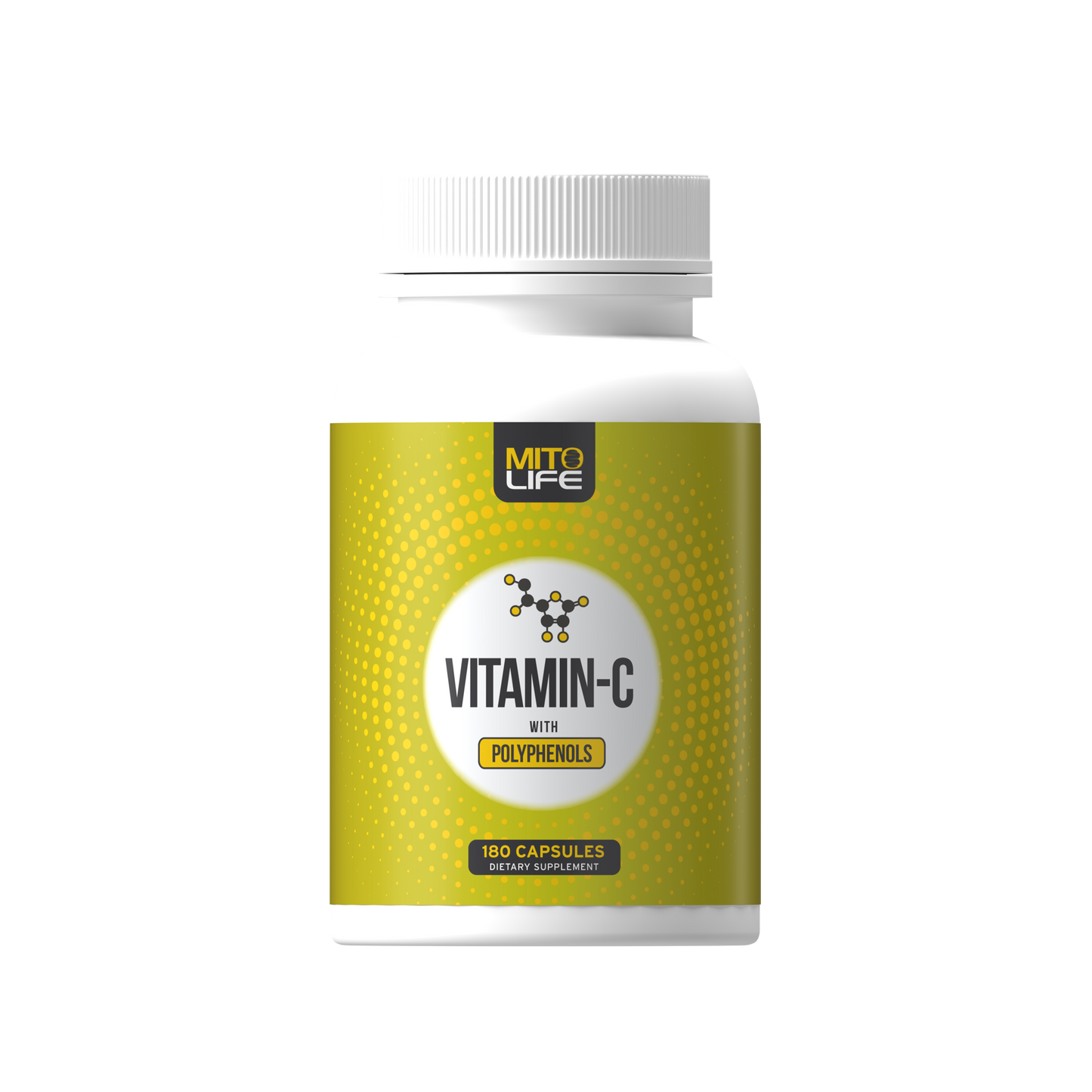VITAMIN C WITH POLYPHENOLS
VITAMIN C WITH POLYPHENOLS
Couldn't load pickup availability
ABOUT
ABOUT
Vitamin C, also known as ascorbic acid, is far more than just an immune booster. It is a fundamental regulator of electron exchange in the body, acting as a redox balancer. This means it plays a crucial role in controlling oxidation and reduction processes, essential for cellular health.
For instance, immune cells use vitamin C to produce hydrogen peroxide to eliminate pathogens, but it also ensures excess hydrogen peroxide is neutralized. Vitamin C is equally important in recycling vitamin E, highlighting its role in maintaining overall redox balance.
THE MODERN WORLD & THE NEED FOR VITAMIN C
In today’s world, exposure to electromagnetic fields (EMFs), heavy metals, and other environmental stressors disrupts our mitochondria’s ability to function optimally. These tiny powerhouses of our cells rely on a balanced redox state to generate energy and sustain the electrical activity of our bodies.
Ascorbate, the active form of ascorbic acid, is present in nearly every tissue, supporting this essential balance. Regular supplementation of ascorbic acid increases plasma ascorbate levels, gradually replenishing tissue stores over time, fortifying resilience in an increasingly toxic environment.
THE MISCONCEPTION OF "WHOLE FOOD VITAMIN C"
In recent years, ascorbic acid has been unfairly dismissed in favor of "whole food vitamin C" supplements. However, this trend ignores the overwhelming scientific evidence supporting ascorbic acid’s benefits. Thousands of clinical studies, along with research by Nobel Prize-winning chemist Linus Pauling, emphasize the critical role of ascorbic acid in cardiovascular health, collagen production, and overall well-being.
Unlike humans, most animals naturally produce vitamin C in its pure ascorbate form, not as part of a "whole food complex." Interestingly, these animals rarely suffer from cardiovascular or collagen-related diseases, reinforcing the idea that adequate ascorbate intake is essential for human health.
THE CASE FOR HIGHER DOSES OF VITAMIN C
The Riordan Clinic has extensively documented the use of high-dose vitamin C therapy for conditions such as cancer and viral infections, demonstrating its role in immune function and recovery.
Biochemist Irwin Stone even proposed that humans suffer from a genetic condition called hypoascorbemia, a deficiency caused by our inability to synthesize vitamin C. He argued that the ideal intake should mirror what other mammals produce naturally, ranging from 1.8 to 15.2 grams daily depending on stress levels. This far surpasses the recommended daily allowance of just 70 mg, which may be insufficient for modern living conditions.
THE BOTTOM LINE
Humans lack the enzyme L-gulonolactone oxidase, which converts glucose into vitamin C, making dietary intake essential. Given the increasing burden of environmental toxins, EMFs, and stressors, our need for ascorbic acid is greater than ever. The evidence is clear: high-quality vitamin C supplementation is not just beneficial, it is necessary for optimal health.
BENEFITS
BENEFITS
🛡 Strengthens Immune Function – Supports the production and activity of white blood cells to help fight infections.
⚡ Powerful Antioxidant Protection – Shields cells from oxidative stress caused by free radicals and environmental toxins.
💪 Supports Collagen Production – Essential for healthy skin, joints, and connective tissue integrity.
🩹 Accelerates Healing & Tissue Repair – Speeds up recovery from cuts, wounds, and overall tissue regeneration.
✨ Promotes Radiant, Youthful Skin – Helps maintain a firm, even complexion by reducing signs of aging.
🔥 Boosts Energy Production – Aids in converting nutrients into usable energy for overall vitality.
🩸 Enhances Iron Absorption – Improves the uptake of non-heme iron from plant-based foods, supporting red blood cell formation.
❤️ Supports Heart & Blood Vessel Health – Helps maintain healthy circulation and reduces oxidative stress on the cardiovascular system.
🧘 Reduces Inflammation – May lower inflammatory markers, benefiting overall wellness and longevity.
SUPPLEMENT FACTS
SUPPLEMENT FACTS

SUGGESTED USAGE
SUGGESTED USAGE
💊 Take two capsules daily with or without a meal.
⏳ For additional support, you may take up to three times per day, or as directed by your healthcare professional.
📢 Consistency is key for best results.
⚠️ For adults only. Consult physician if pregnant/nursing, taking medication or have a medical condition. Keep out of reach of children.
REFERENCES
REFERENCES
Oxidative Stress: The Role of Antioxidant Phytochemicals in the Prevention and Treatment of Diseases
Vitamin C elevates red blood cell glutathione in healthy adults
Vitamin C in Disease Prevention and Cure: An Overview
Hypoascorbemia, the genetic disease causing the human requirement for exogenous ascorbic acid
Oxidative stress induced in pathologies: The role of antioxidants
LAB REPORT
LAB REPORT

